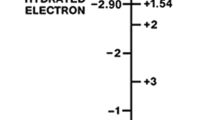Abstract
The present work discusses quantum phase shift sensitivity analysis with respect to the potential energy function. A set of differential equations for the functional derivative of the quantum phase shift with respect to the potential energy function was established and coupled with the variable phase equation. This set of differential equations provides a simple, exact and straightforward way to establish the sensitivity matrix. The present procedure is easier to use than the finite difference approach, in which several direct problems have to be addressed. Furthermore, integration of the established equations can be used to demonstrate how the sensitivity phase shift is accumulated as a function of the interatomic distance. The potential energy function was refined to produce a better quality function. The average error on the phase shift decreased from 9.8 % in the original potential function to 0.13 % in the recovered potential. The present procedure is an important initial step for further work towards recovering potential energy functions in upper dimensions or to recovering this function from cross sections.



Similar content being viewed by others
References
Froberg CE (1947) Calculation of the interaction between 2 particles from the asymptotic phase. Phys Rev 72:519–520
Hylleraas EA (1948) Calculation of a perturbing central field of force from the elastic scattering phase shift. Phys Rev 74:48–51
OBrien TJP, Bernstein RB (1969) Investigation of Hylleraas method for determing potential-energy function from phase shift. J Chem Phys 51:5112–5117
Bargmann V (1949) Remarks on the determination of a central field of force from the elastic scattering phase shifts. Phys Rev 75:301–303
Levinson N (1949) Determination of the potential from the asymptotic phase. Phys Rev 75:1445–1447
Jost R, Kohn W (1952) Construction of a potential from a phase shift. Phys Rev 87:977–992
Newton RG, Fulton T (1957) Phenomenological neutron-proton potentials. Phys Rev 107:1103–1111
Gelfand I, Levitan B (1951) On the determination of a differential equation from its spectral function. Am Math Soc Trasnl 1:253–304
Agranovich ZS, Marchenko VA (1963) The inverse problem of scattering theory. Gordon and Breach, London
Newton RG (1980) Inverse Schrödinger scattering in three dimension. Springer, New York
Newton RG (1982) Scattering theory of waves and particles. Springer, New York
Chandan K, Sabatier PC (1989) Inverse problems in quantum scattering theory. Springer, New York
Zakhariev BN, Suzko A, Pontecorvo G (1990) Direct and inverse problems: potentials in quantum scattering. Springer, New York
Mott NF, Massey HSW, Massey HSW (1965) The theory of atomic collisions. Clarendon, Oxford
Ho T, Rabitz H (1988) Reconstruction of intermolecular potentials at fixed energy: functional sensitivity analysis approach. J Chem Phys 89:5614–5623
Guzman R, Rabitz H (1987) Forward and inverse functional variations in elastic scattering. J Chem Phys 86:1395–1406
Bernstein R (1979) Atom-molecule collision theory. Plenum, New York
Morse PM, Allis WP (1933) The effect of exchange on the scattering of slow electrons from atoms. Phys Rev 44:269–276
Drukarev GF (1965) The theory of electron-atom collision. Academic, New York
Calogero F (1967) Variable phase approach to potential scattering. Academic, New York
Lemes NHT, Borges E, Braga JP (2009) Rate constants and absorption coefficients from experimental data: An inversion procedure based on recursive neural networks. Chemom Intell Lab Syst 96:84–87
Braga JP, Knowles DB, Murrel JN (1986) A theoretical study of the non-adiabatic charge transfer process Ar 2 +(3 P) + He(1 S) → Ar +(2 P) + He +(2 S). Mol Phys 57:665–674
Martinazzo R, Bodo E, Gianturco FA (2003) A modified Variable-Phase algorithm for multichannel scattering with long-range potentials. Comput Phys Commun 151:187–198
Viterbo VD, Lemes NHT, Braga JP (2014) Variable phase equation in quantum scattering. Revista Brasileira de Ensino de Física 36:1310/1–1310/5
Lemes NHT, Sebastião RCO, Braga JP (2006) Potential energy function from second virial data using sensitivity analysis. Inverse Probl Sci Eng 14:581–587
Wing GM, Zahrt JD (1991) A Primer on Integral Equations of the First Kind: The Problem of Deconvolution and Unfolding. Society for Industrial and Applied Mathematics, Philadelphia
Forsythe GE, Moler CB (1967) Computer solution of linear algebraic systems. Prentice-Hall series in automatic computation. Prentice-Hall, Englewood Cliffs
Braga JP (2001) Numerical comparison between tikhonov regularization and singular value decomposition methods using the l curve criterion. J Math Chem 29:151–161
Hansen PC (1987) Rank-deficient and discrete ill-posed problems: numerical aspects of linear inversion. Society for Industrial and Applied Mathematics, Philadelphia
Acknowledgments
We would like to thank Conselho Nacional de Desenvolvimento Científico e Tecnológico (CNPq) and Fundação de Amparo à Pesquisa do Estado de Minas Gerais (FAPEMIG) for their financial support.
Author information
Authors and Affiliations
Corresponding author
Additional information
This paper belongs to Topical Collection Brazilian Symposium of Theoretical Chemistry (SBQT2013)
Rights and permissions
About this article
Cite this article
Lemes, N.H.T., Braga, J.P., Alves, M.O. et al. Potential energy function information from quantum phase shift using the variable phase method. J Mol Model 20, 2317 (2014). https://doi.org/10.1007/s00894-014-2317-2
Received:
Accepted:
Published:
DOI: https://doi.org/10.1007/s00894-014-2317-2




